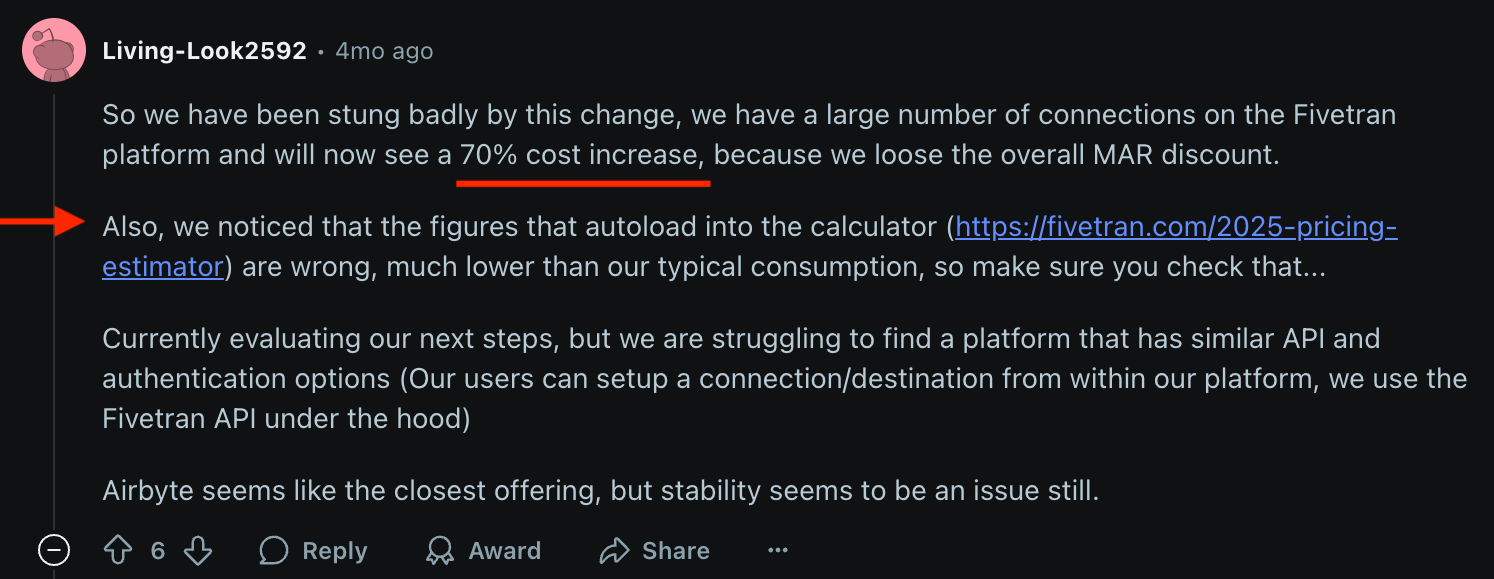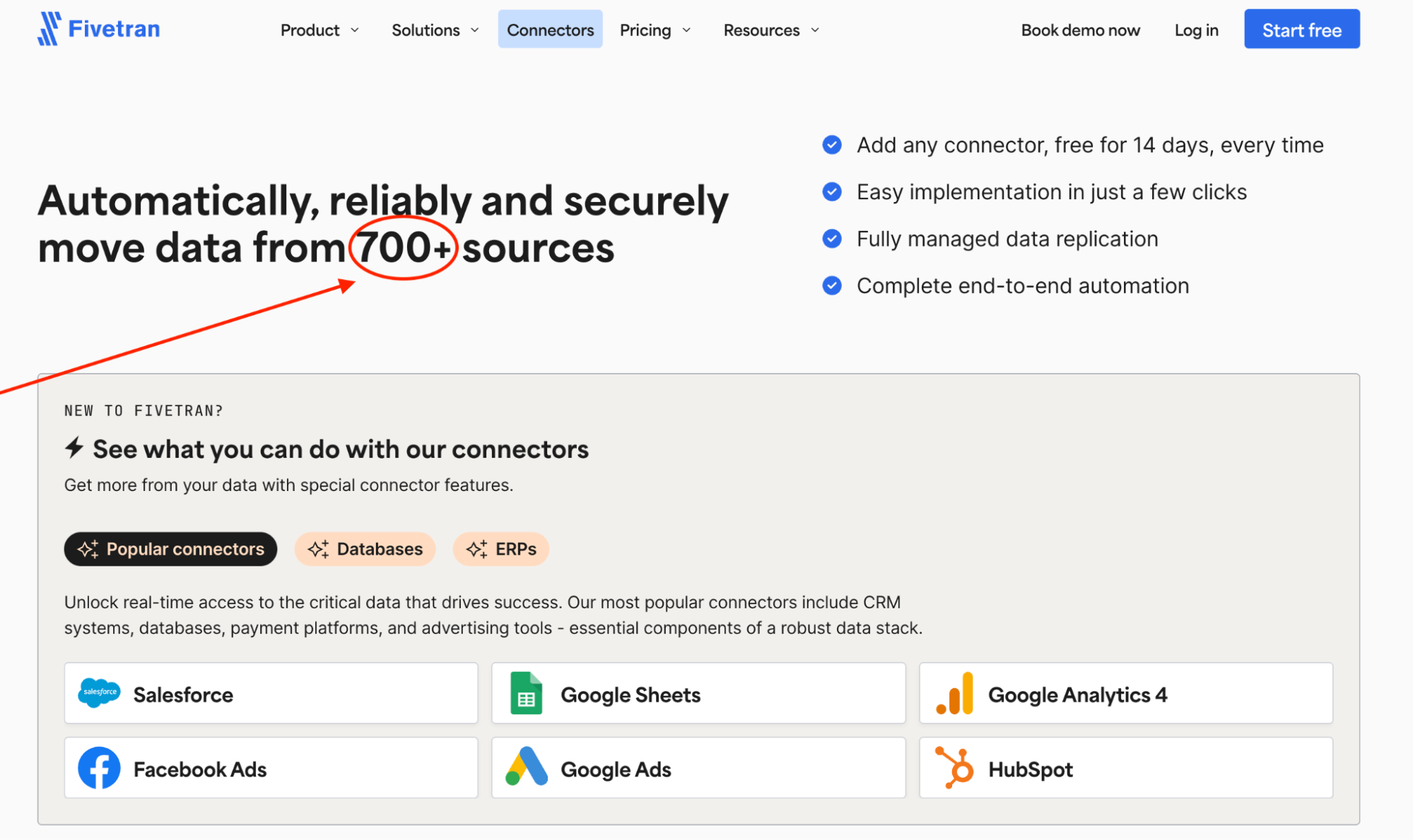TL:DR
Fivetran is a data integration service that helps you move data from various sources into your data warehouse. It's known for its wide range of connectors and automated schema management but can be expensive, especially with its new pricing model.
Who it’s best for:
Companies with existing data warehouses and BI layers that need reliable, automated data replication from many sources and have technical staff to manage the pipelines.
Key features at a glance:
| Feature | Fivetran |
| Integrations | 700+ connectors |
| Stable connections | Generally reliable, but not a universal guarantee |
| Ease of use | Requires technical expertise and know-how |
| Data blending | Requires SQL, dbt, or a third-party tool |
| Internal dashboards | Not available |
| Customizable reports | No reports available, you’ll need a visualization tool like Looker Studio |
| Report sharing & automation | Not available, you’ll need a visualization tool to share reports |
| Security features | SOC 1 & SOC 2, ISO 27001, PCI DSS Level 1, HIPAA, GDPR and CCPA compliant, RBAC |
Pros ✅
- Wide range of connectors available
- Automated schema management
- Generally reliable core connectors and data syncing
- Excellent documentation
Cons ❌
- Unpredictable and high pricing
- No visualization dashboards and reports available – you’d need an external tool for this
- Requires technical know-how to use it
- Inconsistent and slow customer support
Why You Can Trust This Review
At Whatagraph, we don’t review tools we haven’t banged our heads against ourselves.
We work directly with marketing agencies, in-house data teams, and digital analysts who are deep in the weeds—reporting across Meta, GA4, Shopify, CRMs, SQL pipelines, and everything in between.
For this Fivetran review, we:
- Built a clean Fivetran workspace from scratch.
- Connected real-world marketing sources like Google Analytics and Instagram Business.
- Synced them into a Snowflake warehouse and visualized the output in Looker.
- Logged setup times, sync failures, and support interactions.
- Reviewed 100+ verified G2, Capterra, and Reddit threads for user feedback.
Our goal is to help you make an informed decision, whether that leads you to Fivetran, to Whatagraph, or to another solution entirely.
Fivetran Pricing
Fivetran employs a usage-based pricing model, primarily determined by Monthly Active Rows (MAR).
A MAR is any unique row of data that Fivetran adds or updates in your destination (like Snowflake, BigQuery, etc.) within a given month. If a row is updated multiple times, it only counts as one MAR for that month.

You have the option to move forward with a monthly commitment or get up to 22% off on an annual contract—but these contracts start at a $12,000/year minimum.
Here’s the major change in 2025: Fivetran moved its pricing tiers from the account level to the connection level.
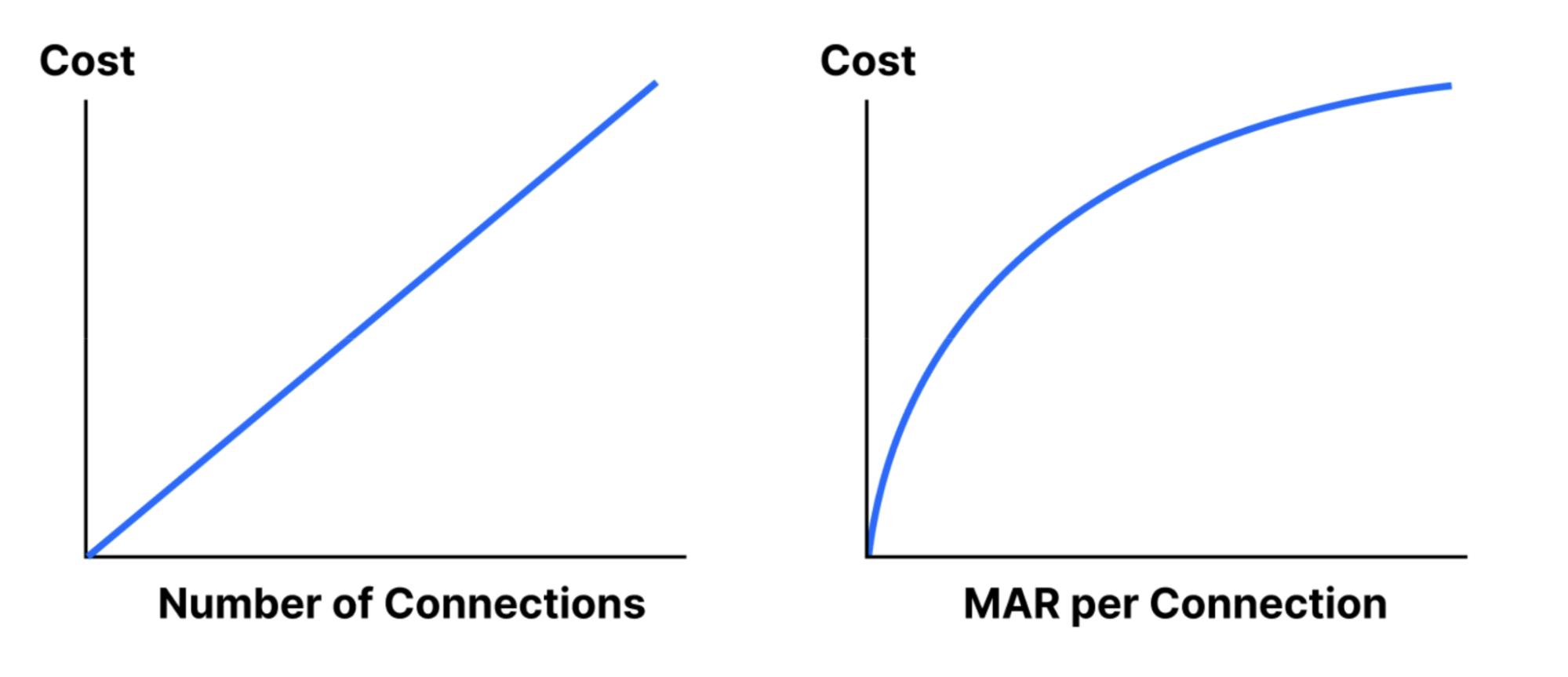 What this means for you:
What this means for you:
Previously, your total MAR across all your connectors was aggregated to determine your pricing tier. Now, Fivetran states, "tiering is applied at the connection level." They explain that, "The change is calibrated so that the impact for the typical user is neutral."
However, they also clarify: "Users with many equal-sized connections will see increased prices, while users with one dominant connection will see decreased prices."
To get a real feel of this new model, I test drove their pricing estimator from within my Fivetran workspace.
- 1 source connector: Instagram Business
- 1 warehouse destination: Snowflake
- ~270,000 MAR total (pretty standard for an active campaign or two)
- 10,000 monthly model runs for basic transformations
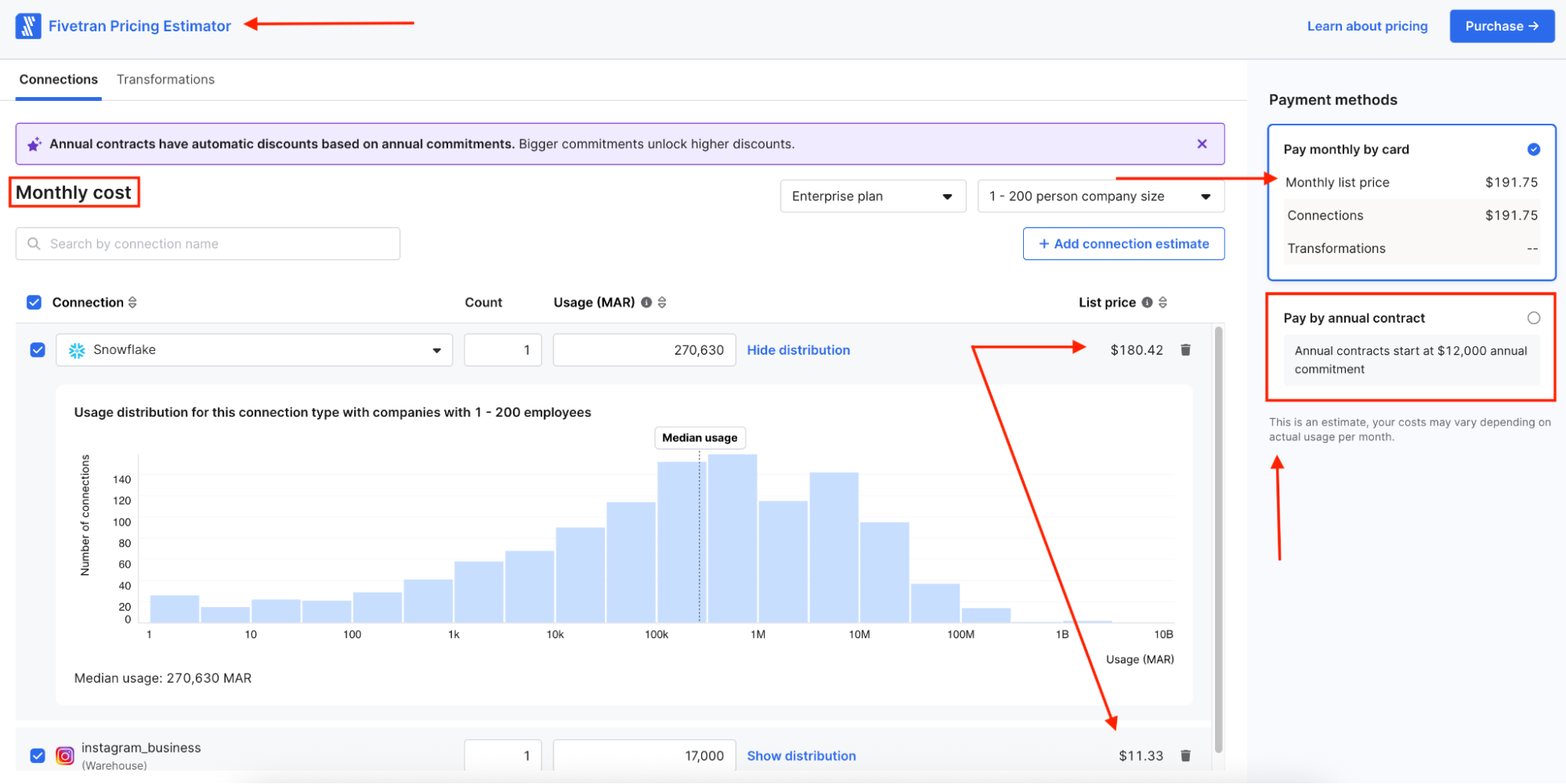 My estimated cost, billed monthly under their "Enterprise plan" on my free trial (which is often needed for features like 15-minute syncs), came out to:
My estimated cost, billed monthly under their "Enterprise plan" on my free trial (which is often needed for features like 15-minute syncs), came out to:
- Connections: $191.75
- Transformations: $50.00 (the first 5,000 model runs are free, the next 5,000 at $0.01 each)
- Total estimated monthly cost: $241.75
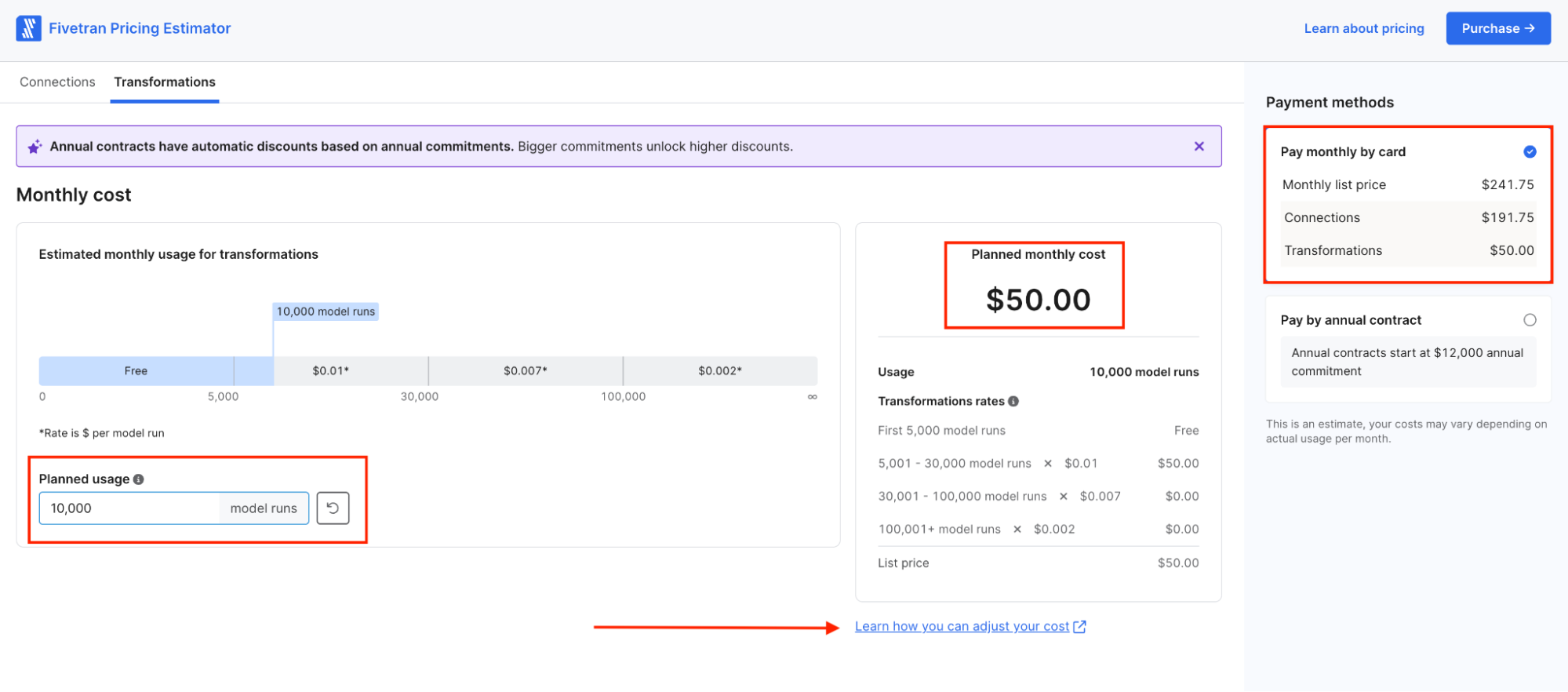 That’s $2,900+/year for just one client’s worth of data. (Assuming they have only one platform to monitor…which is often not the case.)
That’s $2,900+/year for just one client’s worth of data. (Assuming they have only one platform to monitor…which is often not the case.)
Now, if you’re a growing agency with these specifications, for example:
- 6 clients
- 3 platforms each (e.g., Meta, Google Ads, LinkedIn Ads)
- All feeding into 1 shared warehouse (like BigQuery or Snowflake)
- Running light transformations on about 20 models per month
Based on my exploration of their estimator and the per-connection pricing structure:
- You’re likely looking at easily crossing $1,000/month in connection costs alone.
- Then, add another $100–$300/month for those transformations (assuming your 20 models run daily, you'd be well past the 5,000 free runs and into paid territory for a good portion of them).
Your Fivetran bill is now likely north of $15,000/year.
If you’re balking at this number, you’re not the only one.
Reading the recent discussions on Reddit, users are not happy with this change…
At all.
One Reddit user in r/dataengineering is actively looking for Fivetran alternatives because with the new pricing model, they expect to see a “70% cost increase.”
They also note: “Also, we noticed that the figures that autoload into the pricing calculator are wrong, much lower than our typical consumption, so make sure you check that…”
And this isn't an isolated sentiment when it comes to billing surprises.
Another discussion in the r/Fivetran community calls the MAR pricing model “deadly”:

The user adds: “If you misjudge the number of rows you're pulling and/or make an oversight in one of your connections and run it even for a few days before noticing.. your bill for the entire month could be 3x normal.”
But hey, good news if you’re a startup part of Y Combinator: Fivetran offers $50K in free usage through their Startup Program. It's a generous runway to test pipelines without burning your budget—ideal if you're still building your stack.
What does Fivetran’s pricing mean for your budget?
- Calculate your Total Cost of Ownership (TCO): Fivetran is just one component of your data stack. You also need to allocate funds for your data warehouse (like Snowflake, BigQuery, Redshift), your business intelligence or visualization tools, and potentially specialized personnel to manage and optimize your data pipelines.
- Get ready for granular cost tracking: The shift to MAR-tiered pricing means that you’re now forecasting and optimizing costs for every single data source, not just one big bucket.
- Do you need to use a lot of connections? While Fivetran calls the pricing update "neutral for the typical user," losing account-level MAR aggregation can bite. If you’re juggling numerous diverse data feeds, your total costs could climb as each connector lands in its own, potentially pricier, MAR tier.
On a brighter note, not getting dinged for re-syncing unchanged data is a plus.
If Fivetran's pricing model seems like a lot to take in…it's because it is.
On the other hand, Whatagraph takes a more direct and personalized route to arrive at your ideal solution and price.
You pay for source credits, not raw volume. A source credit is our clean, transparent way of tracking how many data sources, blends, or transfers you’re actively using.
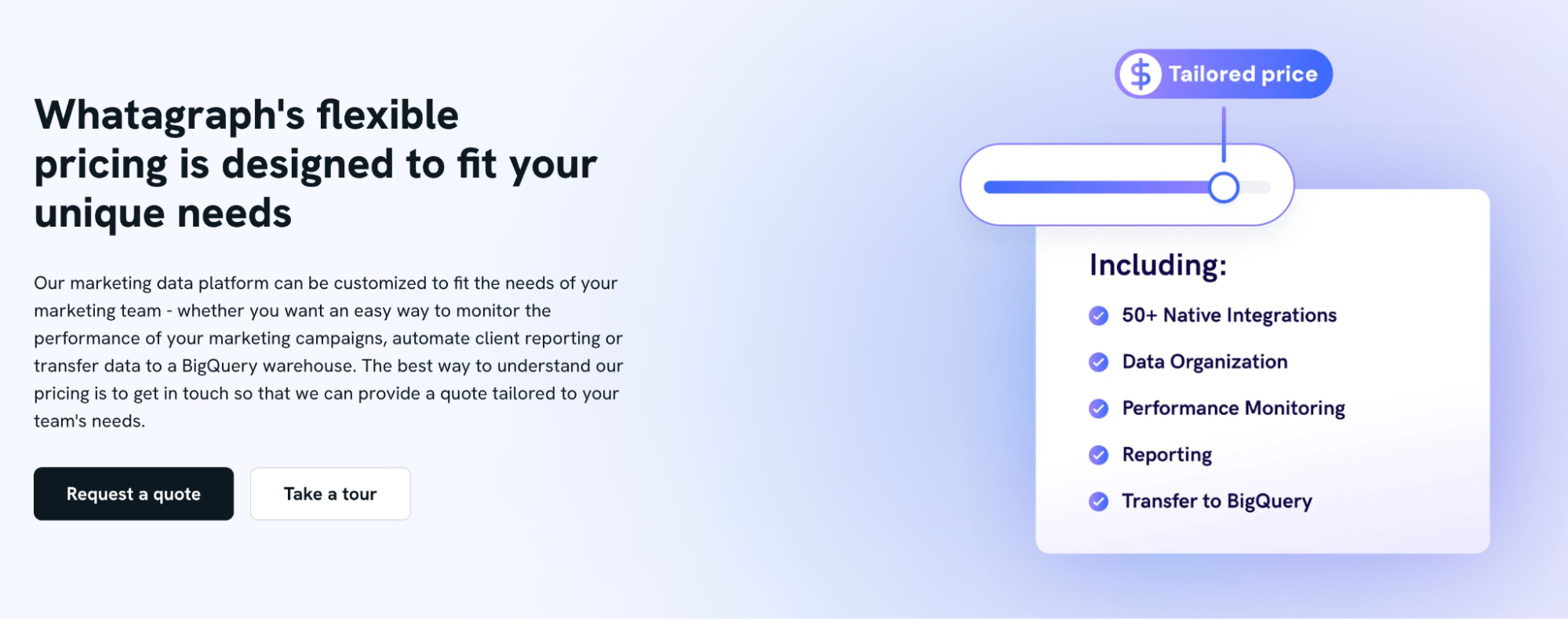
Real User Reviews: What are Customers Saying About Fivetran?
What's the real Fivetran score from users in the trenches? I went deep and wide.
Reddit threads, X updates, YouTube videos, Instagram comments; verified review platforms like G2, Capterra, GetApp, Gartner—you name it, I trawled it.
Let's get to the unfiltered truth—the wins, the warnings, and the “wish-I-knew-thens.”
Fivetran pros: What users love
✅ Huge connector library
Users rave about hundreds of prebuilt connectors across marketing, sales, finance, and ops tools—Meta, HubSpot, Snowflake, even those obscure edge cases you thought you'd have to ingest manually.
Saulo V., a Senior Data Engineer, says on G2:
It has a lot of connectors that allows you to ingest data from many sources…also allows SDKs to create your own connector and integrate to all tools for the strange case when they don't have a built-in connector.
✅ Easy to use
The user interface is clean, intuitive, and beginner-friendly. Multiple users said they could navigate and set up integrations without any hand-holding.
A verified user praises Fivetran for its user-friendliness: “I found the UI simple to navigate the very first time I used it without any need for additional help.”
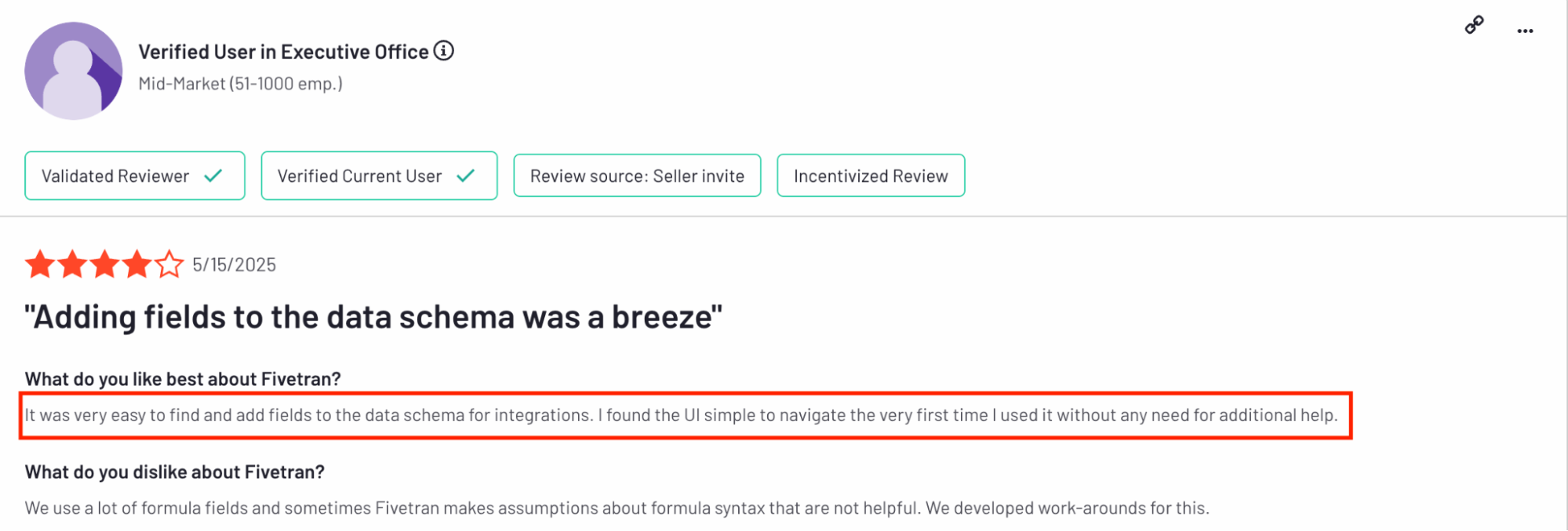
✅ Helpful support documentation
Setup guides are well-organized and readable—not just for engineers, but also for analysts and ops folks who need to get up to speed quickly.
A verified user on G2 says Fivetran “just works” and praises their overall platform support:
Support for hundreds of connectors, good documentation, and support tickets are typically resolved in a reasonable amount of time.
Fivetran cons: Where users get frustrated
❌ Pricing is steep and opaque
Since Fivetran rolled out their new MAR-tiered model earlier this year, X and Reddit have been abuzz. The most recent reviews on G2 and Capterra too, cite cost as the number one siren call of frustration.
In fact, looking at the most recent, verified G2 reviews from 2025, 6 out of 17 reviewers—roughly 35%—highlighted Fivetran’s cost structure as their most significant con.
One verified user complains about the impracticality of scaling with the new pricing model:
The pricing model, specially the new "MARs per connector" pricing model. We would use it for more sources, specially, event sources, but it is impractical.
Another says that the only downside they face with Fivetran is the cost: “The associated cost is not cheap.”
And this sentiment is louder on social media.
Justin Butlion’s lamentation on X went on for so long that I couldn’t even fit it neatly into a screenshot…
He does cede that Fivetran is “...by far the most reliable ETL solution I've worked with and they do have great coverage (both width and depth).”
But his gripe is with the price: “Fivetran is now 4 - 8X more expensive than alternatives on the market.”
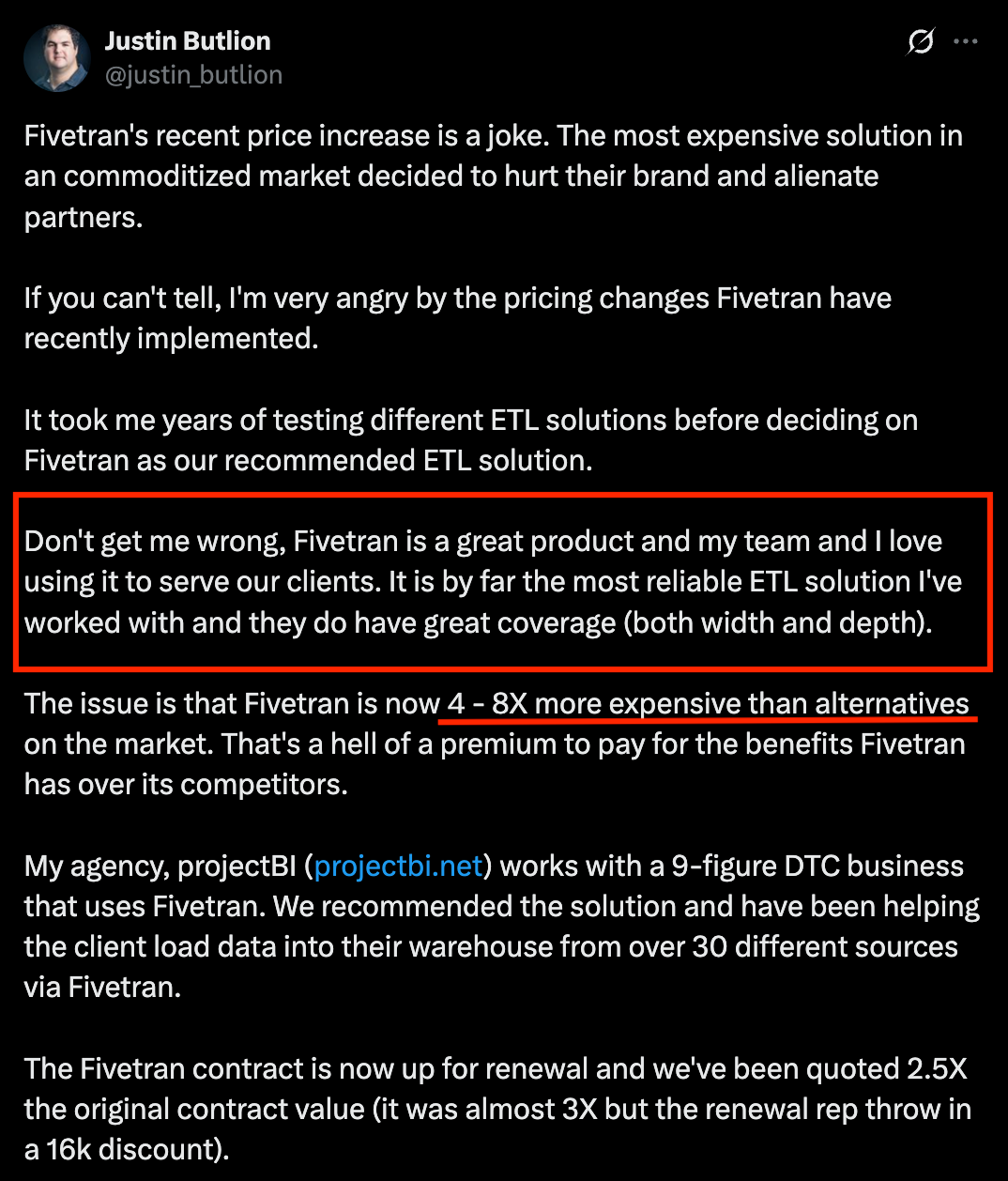 ❌ Changes ship fast and sometimes break things
❌ Changes ship fast and sometimes break things
Fivetran rolls out frequent updates, but not always fully tested ones. Users report data inconsistencies and outages after rollouts that felt more “alpha” than enterprise-ready.
A verified user says that they’d “...like to see more robust testing and QA before features roll out.”
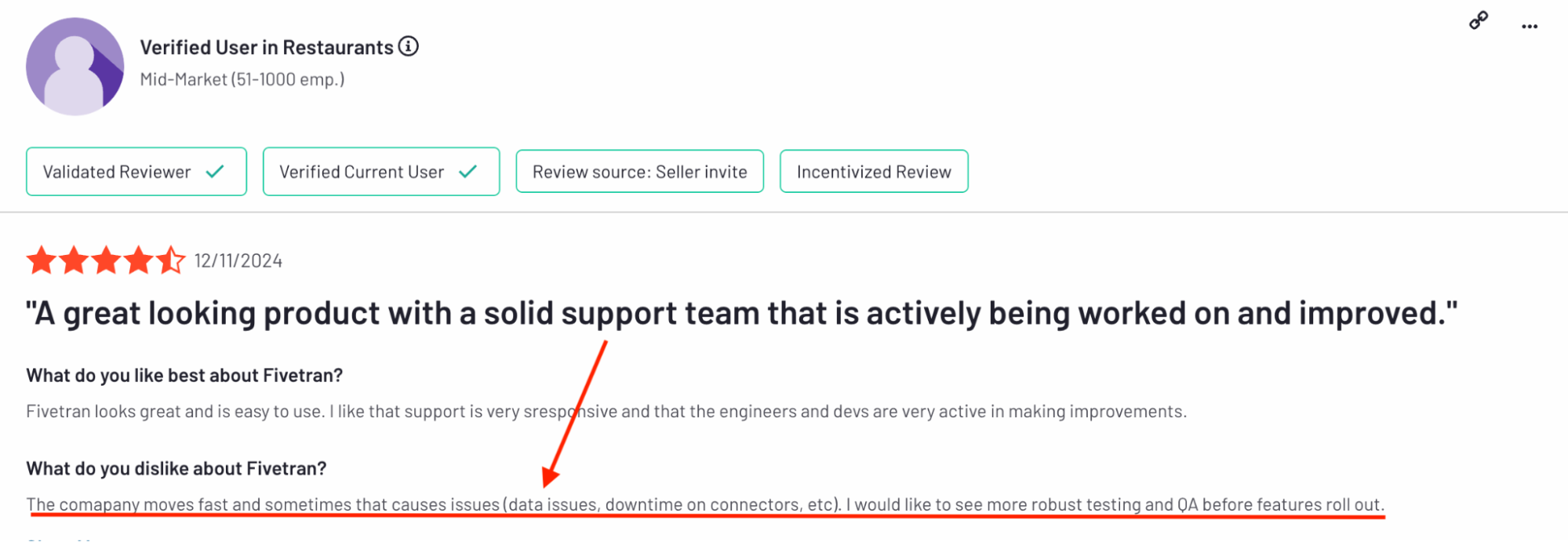
❌ Customer support is hit or miss
While some have good support experiences (especially on higher tiers), others paint a different picture.
Users report critical connectors stopping with "no update on the status page or in incident," forcing them to "reactively reach out to support."
The reigning sentiment is that customer support could be more proactive, especially when “critical jobs” are on the line.
There have been cases where connectors have stopped working or not syncing and there is no update on the status page or in incident…We had to reactively reach out to support to ask why the syncs were not working.
So, What Does Fivetran Do Really Well?
With all those cons, you might be wondering: why do so many companies still choose Fivetran?
Simple.
Because when it works for your use case, it really works.
For example:
- If you're dealing with lots of data sources—and need reliable, automated data replication without building and maintaining dozens of custom pipelines.
- If you already have a data warehouse and BI layer in place.
- If you have technical staff who can manage schema drift, model data, and wrangle sync issues.
Then Fivetran can save you hundreds of hours a year in data movement.
Think: engineer-lite, not engineer-free. You still need someone to own the pipeline.
If your data philosophy revolves around ELT (Extract, Load, Transform)—getting raw data into a powerful cloud-based repository (like a data warehouse such as Snowflake or Google BigQuery, or a data lake built on Amazon S3) ASAP, and then transforming it with tools like dbt—Fivetran is purpose-built for your world.
Even the reviews that highlight Fivetran’s shortcomings admit that as an ELT solution, it’s hard to beat.
But, if you want to build client-ready dashboards, not just move raw data into a warehouse—you’ll need more than Fivetran.
Ajay S., a Software Developer, says it best: “Relying on Fivetran means depending on a third-party service for critical data workflows. If there are outages or issues on their end, it could impact your data integration processes.”
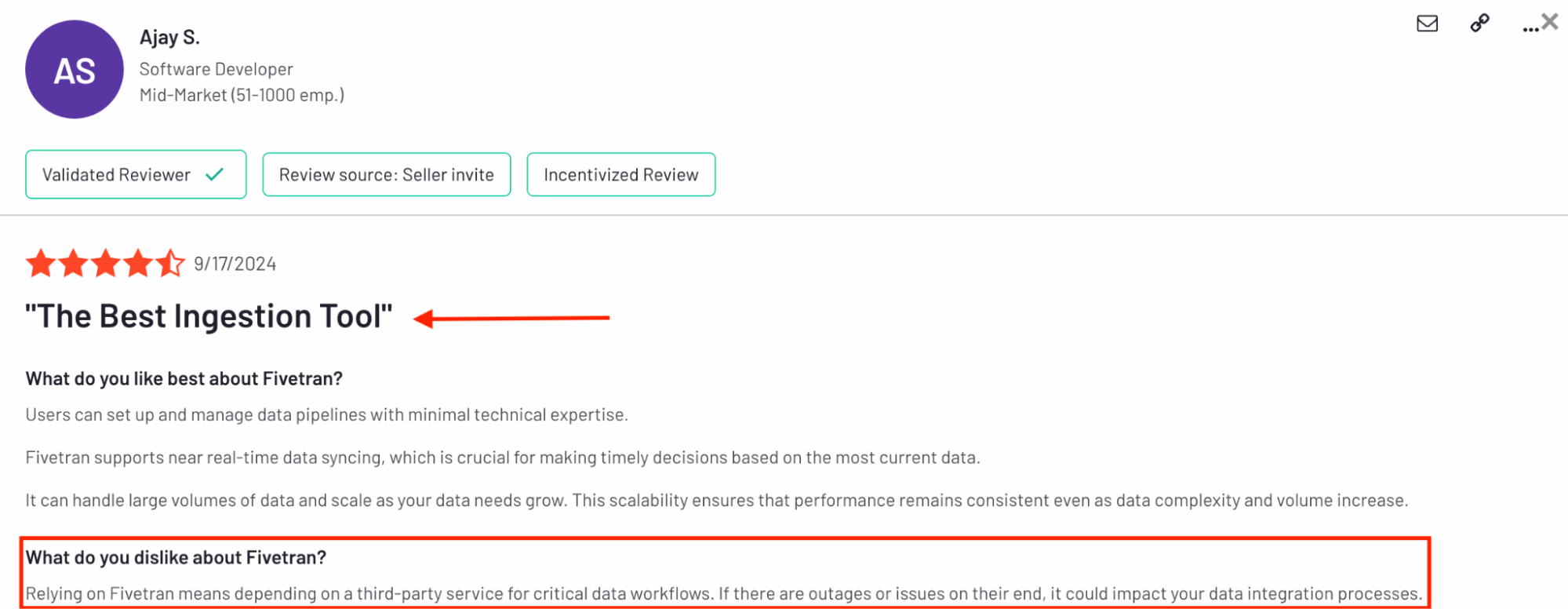
He's right about that dependency—so let's strip away the marketing gloss and truly test Fivetran where it counts.
Fivetran Deep Dive #1: Ease of Setup and Maintenance
If you’re just extracting and loading data, Fivetran is great. If you want full control, be ready to get technical.
Let’s be clear: I’m not a data engineer.
I mostly work in low-code or no-code environments—tools like Whatagraph, Airtable, and Notion. So this section really tests how user-friendly Fivetran is for people who aren’t living in dbt day-to-day.
How much technical knowledge do you need?
This is a "it depends" answer, but here’s my breakdown from a low-code perspective:
For most common SaaS sources (like the marketing platforms I tested), connecting them was incredibly straightforward.
If there’s one thing I love about the platform, it’s the super-friendly microcopy that guides you at every step.
See that “Fastest setup” button? For me, it reduces decision fatigue.
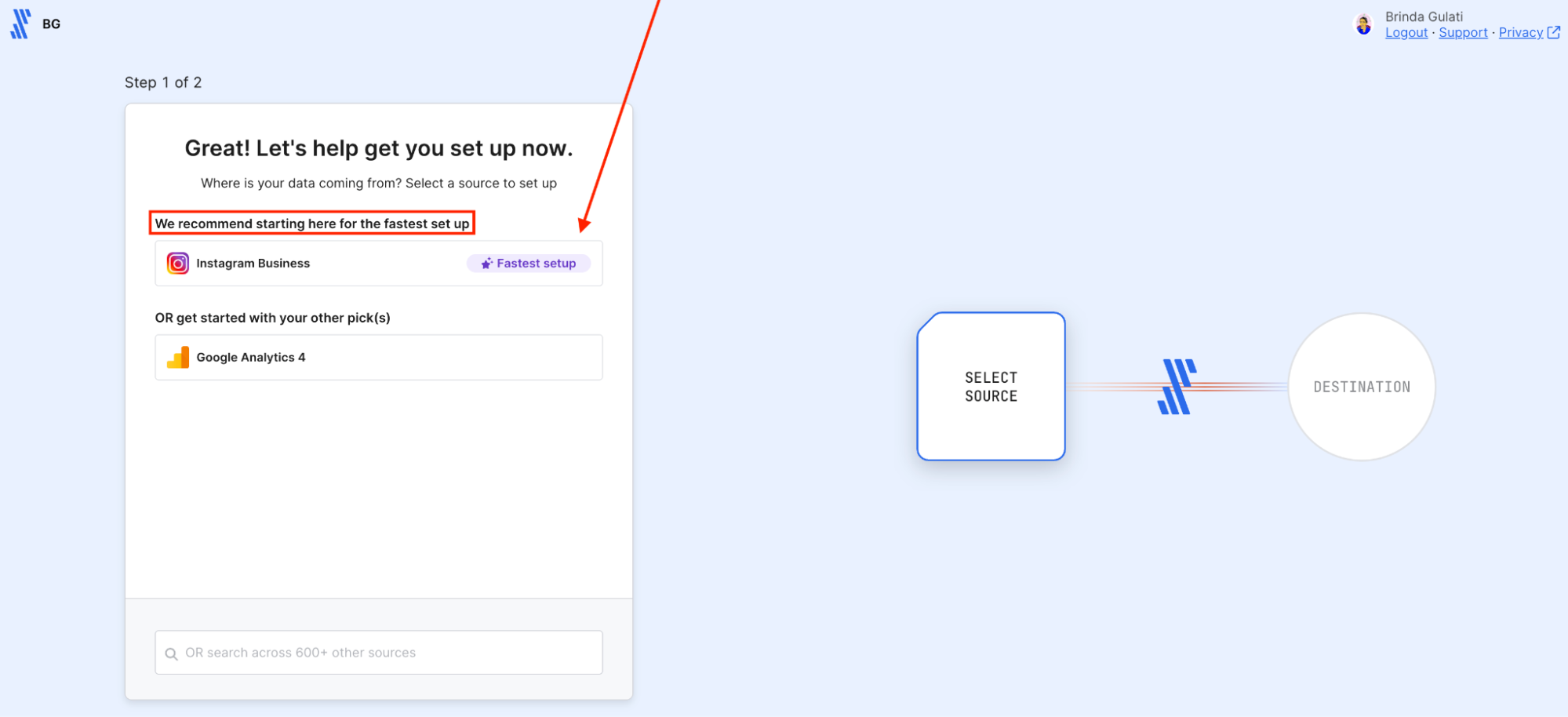 You pick your source, authenticate (usually via OAuth or an API key), choose your destination, and Fivetran generally takes it from there. No coding required (yet), and the UI guides you pretty well.
You pick your source, authenticate (usually via OAuth or an API key), choose your destination, and Fivetran generally takes it from there. No coding required (yet), and the UI guides you pretty well.
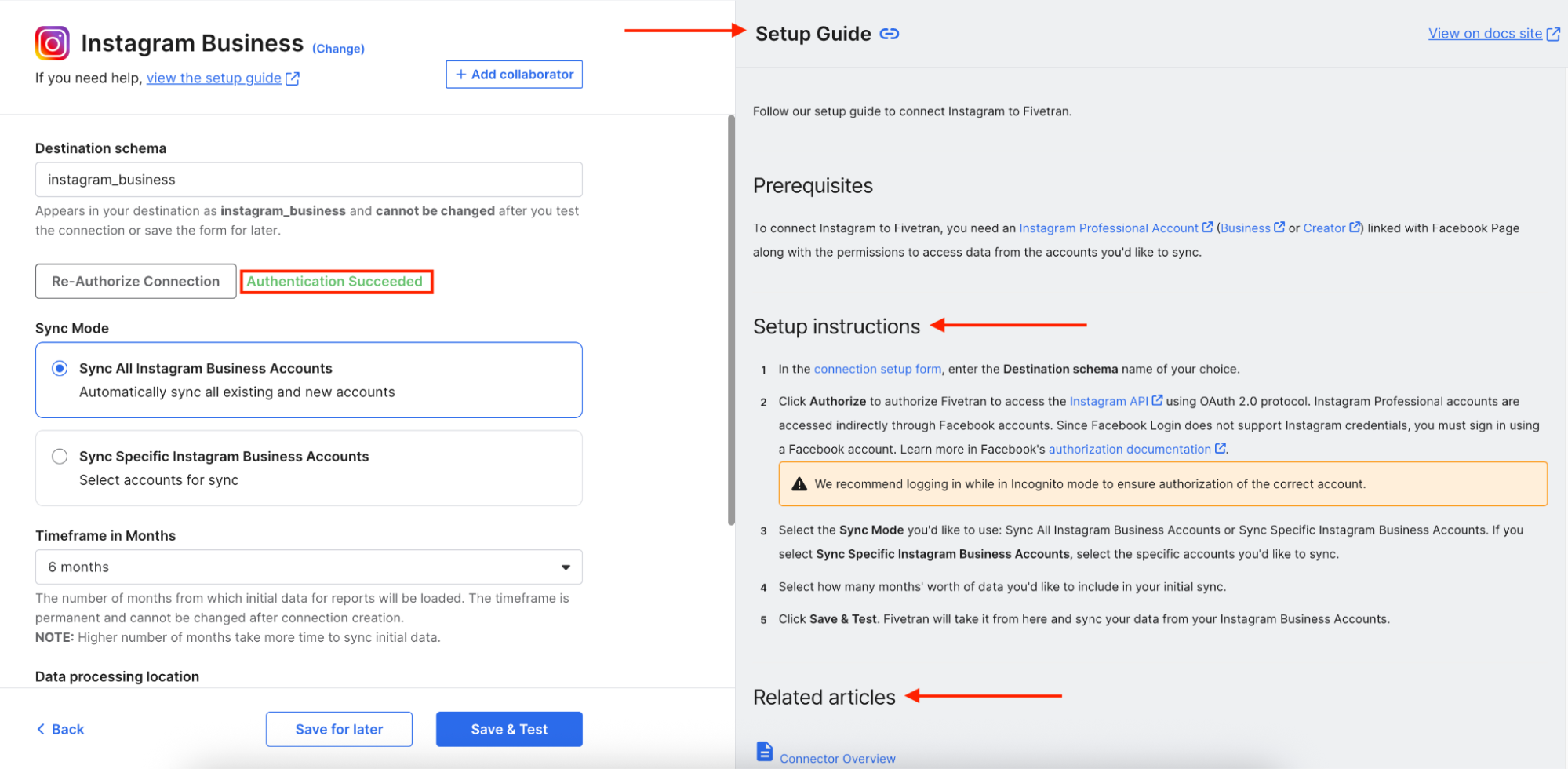
If your goal is just to get raw data from App A to Warehouse B, someone with minimal technical skills but good credentials management can often get it done.
Another thing I adore is the two-pane view.
As you’re connecting your data sources, Fivetran guides you step by step through all of the instructions.
So, even if I’m feeling overwhelmed by the technicality, there’s support documentation right in front of me, instead of me having to read the guide in another tab.
And this is exactly what users love about Fivetran too:
It was very easy to find and add fields to the data schema for integrations. I found the UI simple to navigate the very first time I used it without any need for additional help.
But once you:
- Need a connector Fivetran doesn't offer (and want to use their SDK)
- Run into complex errors; or
- Want to transform that data (clean it, join it, model it for analytics)
You're firmly in developer/engineer land.
So, my verdict: For the initial data extraction and loading part of standard connectors, a tech-savvy non-engineer like me can manage pretty well. But to handle the whole data lifecycle, optimize costs, or deal with transformations, you'll either need to upskill significantly or have a data engineer on speed dial.
Does it work with your current stack?
Again, it depends on what your "current stack" looks like.
- If your stack includes a modern cloud data warehouse: Yes, Fivetran is built for this. It supports all the big players (Snowflake, Google BigQuery, Amazon Redshift, Databricks on AWS or other clouds, etc.) as destinations. If you're already using one, or plan to, Fivetran slots right in as the data ingestion engine.
- For source applications: With its massive connector library, chances are high Fivetran can pull data from many of the SaaS tools you're already using (Salesforce, HubSpot, Google Ads, Meta, Shopify, you name it).
For my test, it "worked" by getting data into Snowflake, which then allowed Looker to access it.
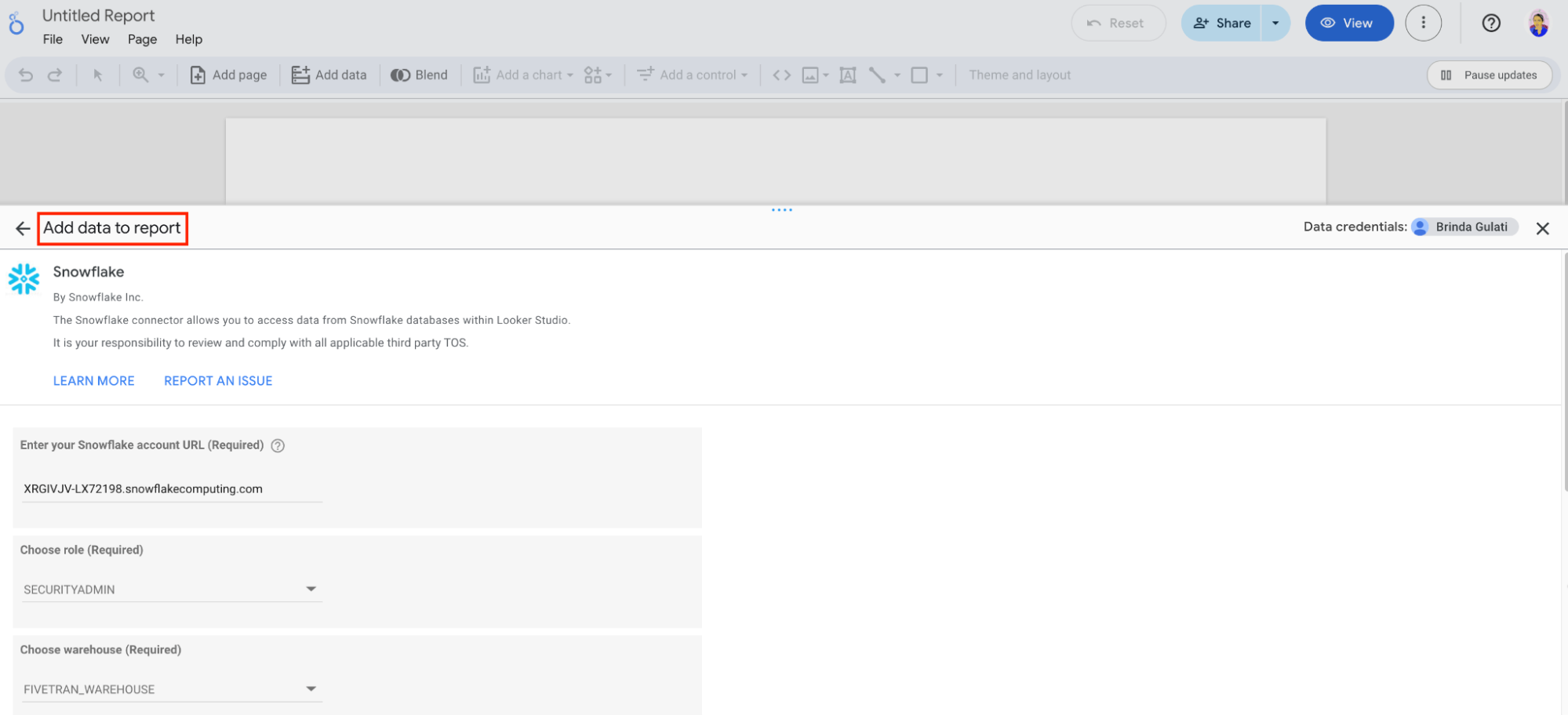
But that's three tools (Fivetran, Snowflake, Looker) to achieve what an all-in-one reporting tool like Whatagraph might do for marketing reporting all by itself. (And cheaper, too.)
Here’s how easy it is to connect your data sources and start visualizing stunning data-driven client reports from within one powerful Whatagraph workspace:
Step 1: Connect your data from 85+ native integrations managed in-house by our engineers.
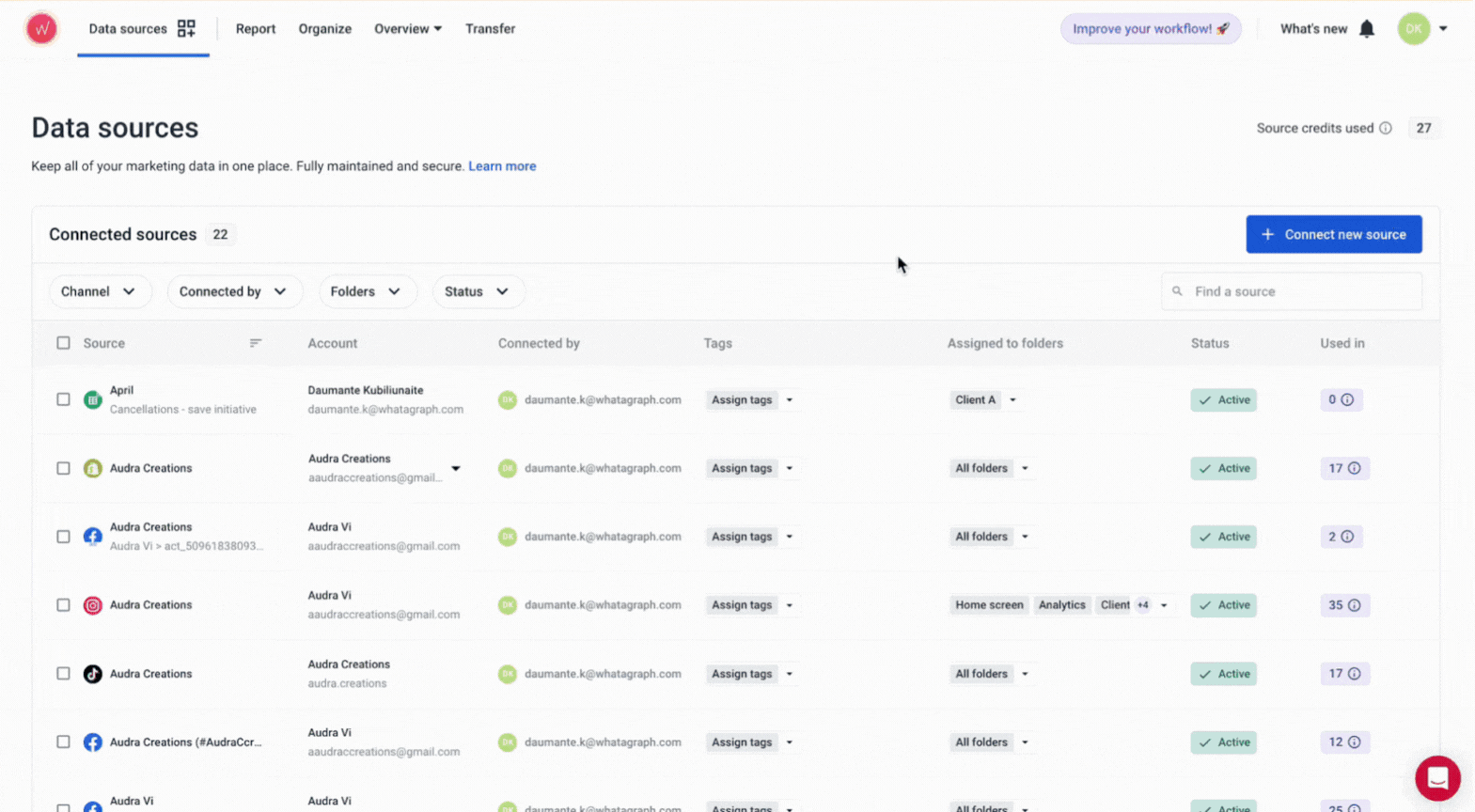 Step 2: Drag and drop widgets from the sidebar onto your canvas to instantly build client-ready reports.
Step 2: Drag and drop widgets from the sidebar onto your canvas to instantly build client-ready reports.
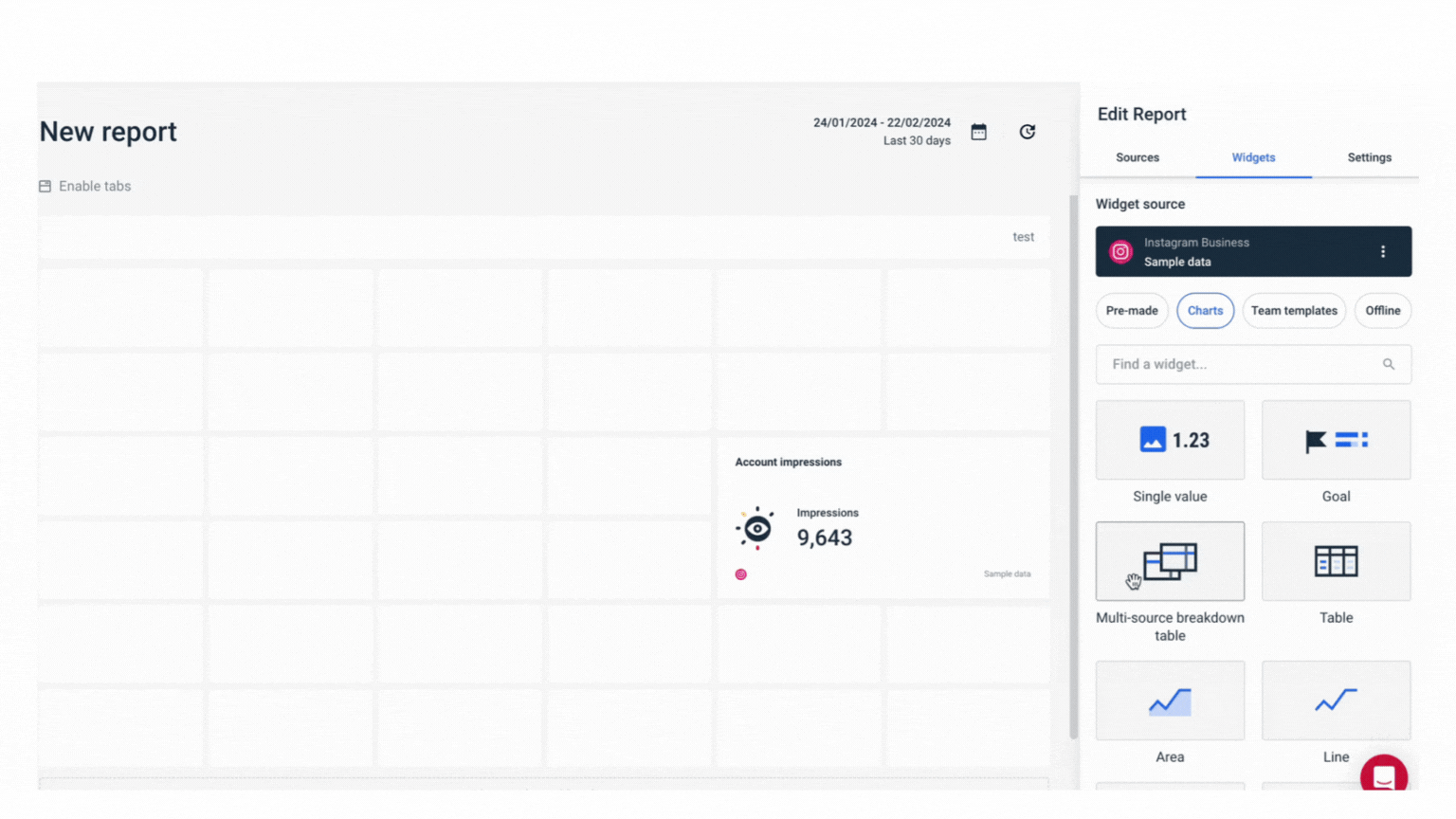
That’s it. Easy peasy, lemon squeezy.
Read how Tanja Keglić, Performance Marketing Manager at Achtzehn Grad, shaved off 5 hours per report by switching from a connector like Supermetrics to a holistic reporting platform—Whatagraph.
Can you self-diagnose issues?
This was a mixed bag for me as a non-engineer:
- The dashboard provides clues: Fivetran has a user dashboard that shows connector statuses, sync histories, and logs. For simple things like a connector needing re-authentication (e.g., a password changed), the UI usually makes it clear, and it's an easy fix.
- Basic error messages are okay: If a sync fails due to an obvious issue at the source or destination, the error shown in the Fivetran UI can sometimes be enough to point you in the right direction.
- When it gets hairy, it gets technical: For more cryptic errors, unexpected data discrepancies, or issues related to MAR consumption, the logs can be very technical. As someone less familiar with debugging data pipelines at a code level, I found I'd likely hit a wall pretty quickly and need to escalate to Fivetran support or a more technical team member.
- Status page limitations: While Fivetran has a status page for platform-wide incidents, some users have found it's not always updated proactively when individual connectors have issues, meaning you might discover a problem before they officially announce it.
Alec R., Data Engineer, says on G2:
The error codes in fivetran are sometime not entirely full fleshed out, which can be confusing where the error is actually located.
So here’s the real friction point: other non-technical members of your team can’t just “jump in” to troubleshoot.
Even if they’re comfortable in tools like GA4 or Looker Studio, they’ll likely stall out when faced with connector logs, schema diffs, or MAR-related sync failures.
The UI surfaces high-level statuses, sure—but it’s not built for collaborative triage across marketing or operations teams.
Fivetran Deep Dive #2: Connector Breadth and Reliability
Fivetran covers 700+ connectors and handles schema drift like a pro. But not every sync is flawless—and complex setups still need a watchful eye.
If Fivetran is known for one thing, it’s this: connect once, sync forever—at least in theory. But does that hold up across all 700+ connectors, or just the polished few?
Let’s find out.
How many out-of-the-box connectors are there?
A lot.
Fivetran boasts over 700 prebuilt connectors—covering everything from the usual suspects (Google Ads, Meta, Shopify, HubSpot) to more niche systems like Zuora, Snowplow, and even some ERP and finance tools.
For most marketing and sales data sources, you’ll probably find what you need without building anything custom.
And in the rare case a connector doesn’t exist—Fivetran offers SDKs and REST APIs so your data team can build custom connectors, though this obviously requires dedicated engineering resources.
That’s part of Fivetran’s appeal: it’s aggressively expanding coverage so you don’t have to build pipelines in-house.
Do syncs actually run smoothly?
This is where the "it depends" answer creeps back in, though with a generally positive lean for many common use cases.
For example, once I set up connectors for Google Analytics and Instagram Business, the data syncs did run reliably in the background. Fivetran has a solid reputation for its "it just works" capability on many of its mature connectors.
But "smooth" isn't a universal connector guarantee.
A verified user calls Fivetran the “best third party ETL” but mentions: “Some connectors are advertised as fully functional but do not work.”
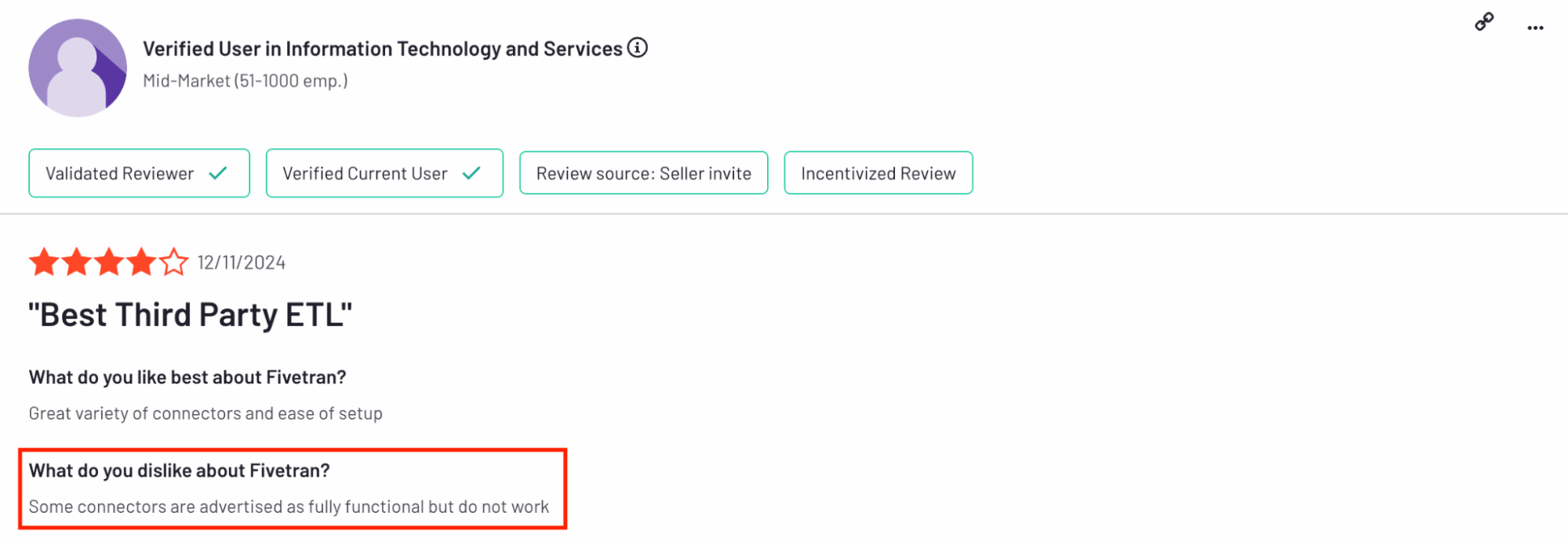
Another user complains that “some connectors are very slow to pick up traction on new feature suggestions.”
How well does Fivetran handle schema changes?
This is one of Fivetran's most lauded strengths, and from my non-technical viewpoint, it's a massive relief.
And Fivetran feedback on schemas is generally positive, like this review on G2:
We were able to connect 30+ data sources and not have to worry about schema drifts and other data engineering tasks.
When your source application adds a new field, changes a data type, or even removes a column, Fivetran is designed to automatically detect and adapt to these changes in your destination warehouse.
New columns generally just appear, and data types are adjusted.
Why this is a big deal (especially if you're not an engineer): Manually managing schema drift is a nightmare. It means constantly monitoring source APIs, updating your pipeline code, and ensuring your database tables match. Fivetran aims to make this entire process invisible and automatic.
But there are caveats:
- If your downstream dashboards expect a static schema, changes can still break reports.
- Schema changes across multi-tenant setups can cause column mismatches, missing tables, or inconsistent types.
So while the system is resilient, it’s not immune—and the more complex your architecture, the more likely you’ll need someone keeping an eye on it.
Fivetran Deep Dive #3: Sync Speed and Flexibility
Fivetran offers a wide range of sync frequencies—from 24 hours down to 1 minute—but the faster you go, the more you’ll pay (and only Enterprise gets that top speed).
What is Fivetran’s idea of “fast,” and how much control do you actually have over sync timing?
How fast and steady are the data syncs?
By default, Fivetran syncs every six hours, according to their documentation. That’s the baseline.
 If you want faster updates, you’ll need to manually adjust the sync frequency—and that’s assuming your plan and usage allow for it.
If you want faster updates, you’ll need to manually adjust the sync frequency—and that’s assuming your plan and usage allow for it.
In my test, standard marketing connectors (like Google Analytics and Instagram Business) synced in under five minutes once kicked off.
But remember: the clock starts from the start of the last sync, not when it finishes. So if a sync takes 25 minutes and you’re set to sync every 30, you’re only leaving a 5-minute buffer before the next one starts.
Fivetran also mentions that the sync schedule uses the same time zone as your destination warehouse, and the very first sync of a 24-hour cycle typically has a baseline start time of midnight in that destination's time zone.
These are good little details to know for precise scheduling.
But users like Sushanth U. mention that they’ve been having sync issues for the past two months with Fivetran.
The Whatagraph advantage: Your marketing data refreshes every 30 minutes—automatically, reliably, and without you lifting a finger.
Can you control sync frequency?
Yes, you do get a say in how often Fivetran fetches your data, and the options are quite specific.
You can adjust the default 6-hour "sync frequency" to better suit your needs. Fivetran provides a clear list of available frequencies you can choose from:
- 1 minute*
- 5 minutes
- 15 minutes
- 30 minutes
- 1 hour
- 2 hours
- 3 hours
- 6 hours (the default)
- 8 hours
- 12 hours
- 24 hours
*That super-fast 1-minute sync frequency comes with a condition: you must have an Enterprise or Business Critical plan to use it. So, if your need for near real-time data is that acute, be prepared for it to influence your subscription tier and, consequently, your costs.
The Fivetran platform provides solid, configurable control over your sync schedules, with the 6-hour default being easily adjustable to suit your needs (and plan). The condition about previous sync completion is an important nuance for understanding timing.
However, for a non-engineer wanting maximum ease and control, the inability to easily deselect unwanted tables within a connector means the "flexibility" has its limits, potentially leading you to sync (and pay for) more data than you strictly need.
Fivetran Deep Dive #4: Data Quality and Transformations
Fivetran delivers clean, accurate data—especially in simple setups—but transforming that data still requires SQL, dbt, or a third-party tool.
Data is only useful if you can trust it and shape it to answer your questions. So, how does Fivetran fare in these critical areas?
How good is Fivetran at preserving data integrity?
This is a core promise of Fivetran: to get data from your source to your destination reliably and accurately.
My experience, and the general consensus among users, is that Fivetran does a solid job of moving data without losing or corrupting it in transit.
But in more complex setups, especially multi-tenant environments, things can get messy. One user reported that connecting the same source across different customers resulted in inconsistent schemas—missing tables, mismatched column types, and different fields showing up per client.
Eric A., Chief Data Officer, enumerates the challenges in multi-tenant environments in Fivetran:
If we connect the same source for different customers, often different table schemas will be delivered to our destination. Columns will appear in one instance but not another.
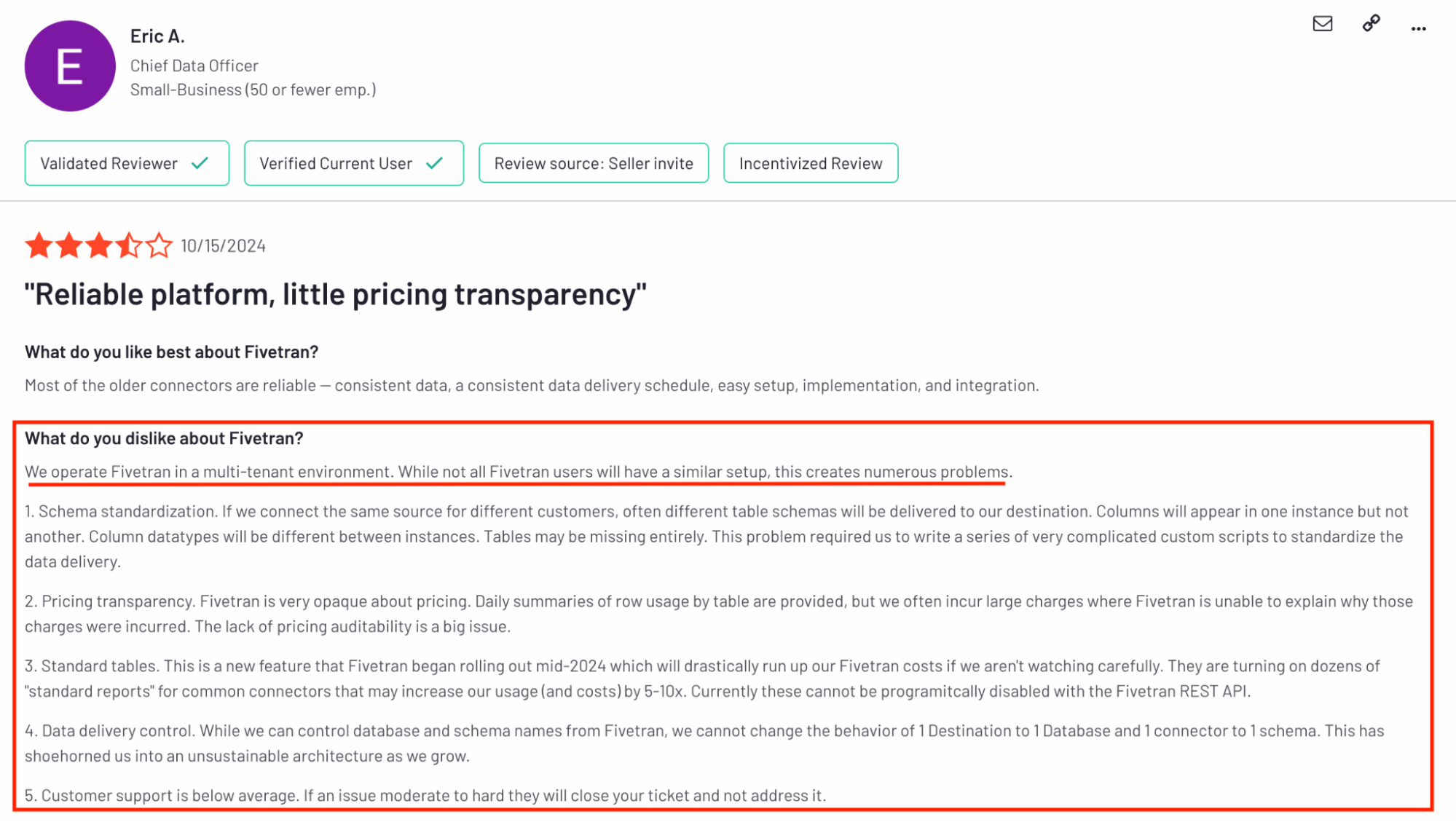
This is a huge problem for data integrity. Because it means the data Fivetran delivers isn't consistently structured, even when it's from the same type of source across different clients.
So, while Fivetran does preserve data integrity in a clean, controlled setup, the more clients or connectors you add, the more hands-on your team may need to get. And that’s before factoring in pricing surprises tied to schema changes or auto-enabled standard tables.
Can you transform data in-app?
Sort of—but don’t expect drag-and-drop magic.
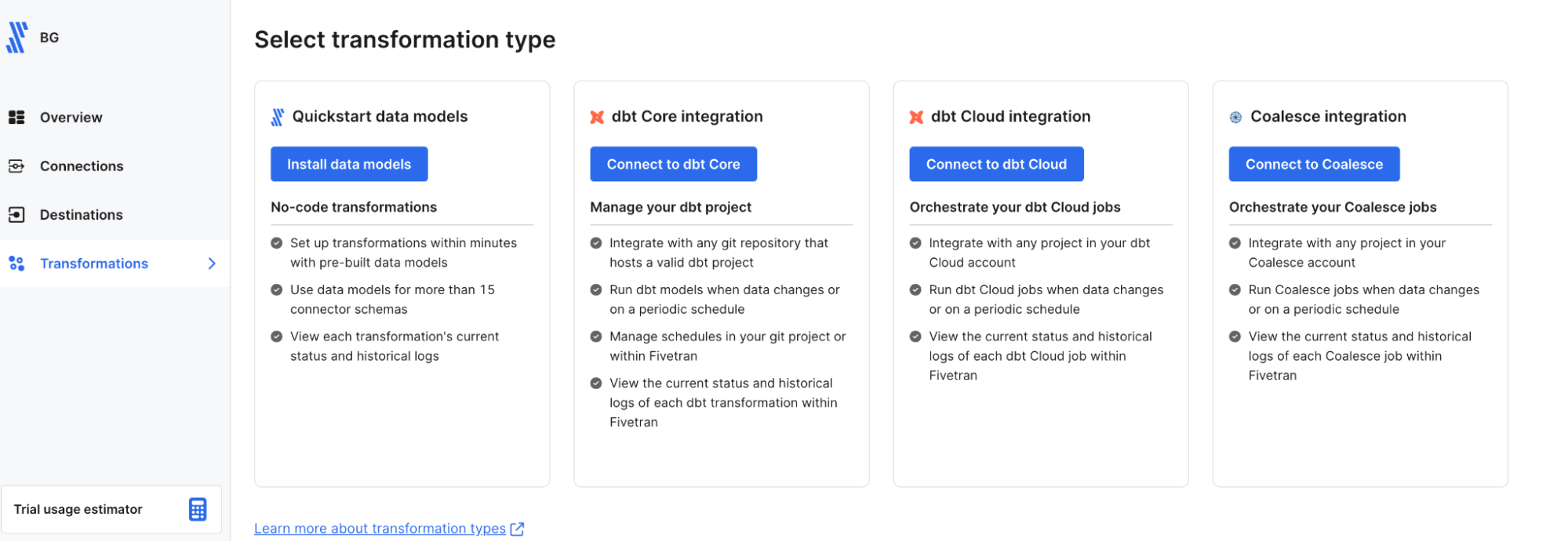
Fivetran offers four transformation options, but most of them still assume you’re comfortable working in SQL or managing code in Git:
- Quickstart data models: The closest thing to “no-code.” You can install prebuilt models for ~15 common connectors (like Google Ads or Salesforce), and Fivetran will run those on a schedule. Setup is simple, but customization is limited.
- dbt Core integration: Connect your Git repo, run dbt models on a schedule or when data changes, and manage everything inside Fivetran. Great if you already live in dbt.
- dbt Cloud integration: Same as above, but managed via your dbt Cloud workspace. Fivetran just triggers and logs the runs.
- Coalesce integration: For teams using Coalesce as their transformation layer, Fivetran can orchestrate those jobs too.
This gives data teams full control over modeling logic—but for non-technical users, it means extra setup and extra help.
A verified user on G2 also says that “...currently the transformations available are quite limited.”
In FULL FINANCE REVIEW’s YouTube review on Fivetran and dbt integration, he summarizes:
While both Fivetran and dbt offer powerful functionalities, the learning curve can be steep, particularly for teams that are not already familiar with data engineering concepts. Setting up Fivetran connectors and configuring dbt models may require a degree of technical expertise, which could be a barrier for businesses without dedicated data engineers or analysts.
If you want a simple “clean and display” flow, you’re better off with a tool that includes built-in modeling or visual logic layers—like Whatagraph.
With Whatagraph, you don’t need to write SQL, build models, or worry about schema drift to start building custom, white-labeled reports.
We automatically clean, map, and reshape your marketing data from tools like Meta, Google Ads, and HubSpot—so you can jump straight to building reports and sharing insights.
All the “T” in ELT happens under the hood, in a visual, user-friendly interface.
Fivetran Deep Dive #5: Customer Support
Fivetran’s support is functional but tiered—fast and helpful for enterprise users, slower and more self-serve for everyone else.
Even with the most intuitive tools, there comes a time when you hit a snag. A connector stops syncing, a weird error message pops up, or those Monthly Active Rows (MAR) numbers just don’t make sense.
What happens then?
Who do you call when something breaks?
If you're on an Enterprise or Business Critical plan, you'll likely get access to priority support, potentially including a named account manager or direct Slack channel.
The Whatagraph advantage: every plan comes with a dedicated Customer Success Manager—no upgrade required, no asterisks. You get a real person, ready to help, regardless of what you're paying.
When I explored the support options directly within the Fivetran dashboard by clicking on "Get Help," I was presented with a pretty clear menu.
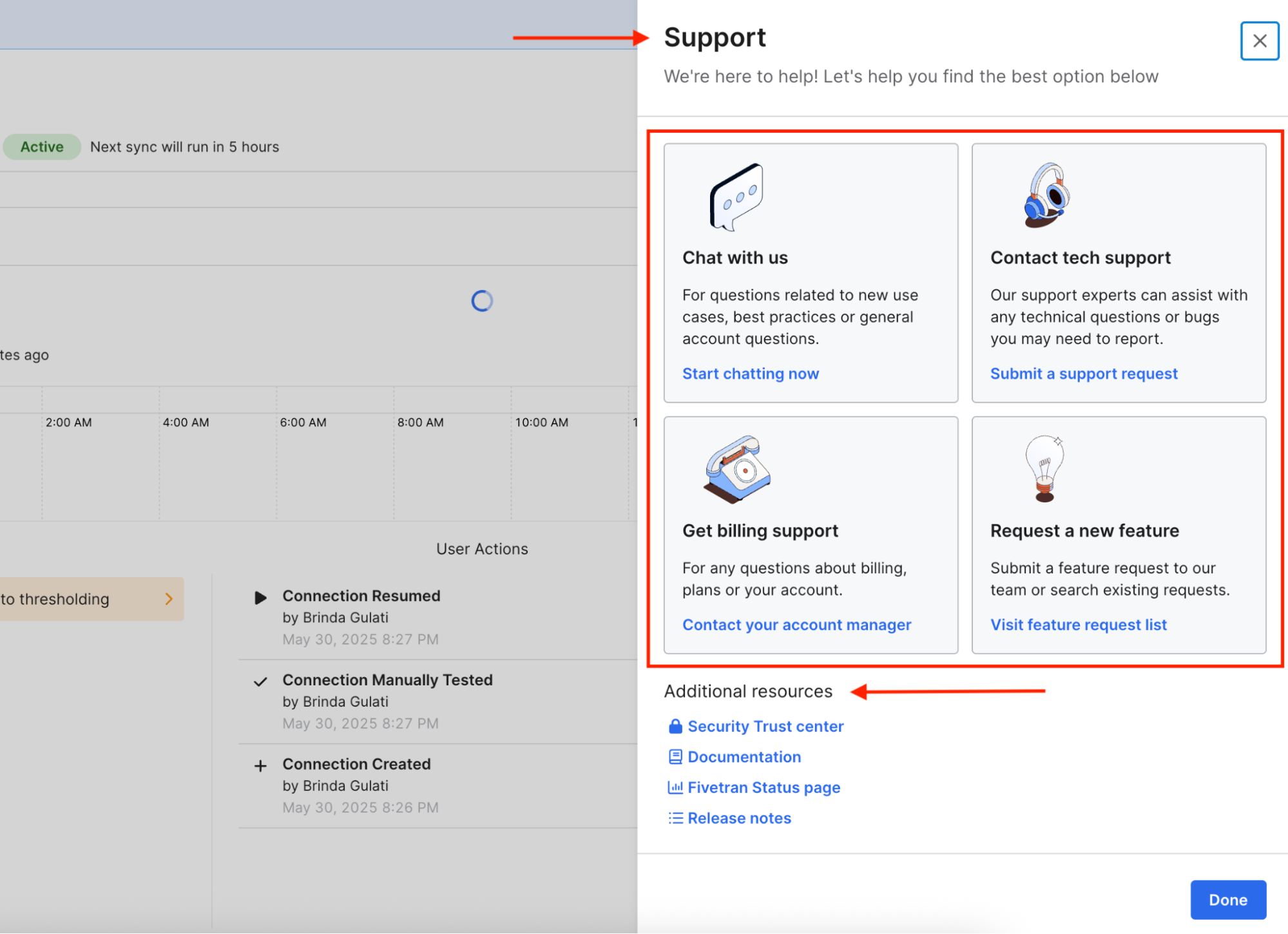 This is the central hub for seeking assistance while you’re inside the platform:
This is the central hub for seeking assistance while you’re inside the platform:
Chat with us: This is your first port of call. However, it opens in a new tab and support may not always be available instantly—in which case, they have a helpful embedded calendar to connect with their support executives. A neat feature, but not practical for time-sensitive requests. Contact tech support: This is the main path for "any technical questions or bugs you may need to report." Clicking this leads you to "Submit a support request."
Contact tech support: This is the main path for "any technical questions or bugs you may need to report." Clicking this leads you to "Submit a support request."
Get billing support: For any money-related queries—"questions about billing, plans or your account." This option directs you to "Contact your account manager."
Request a new feature: If you have an idea for Fivetran or need something it doesn't currently do, there's a path to "Submit a feature request to our team or search existing requests."
BTW, if you ever run into an issue, Whatagraph’s live chat feature is purpose-built to help you within your workspace, and within your time-sensitive window—in less than four minutes.
What are the main ways to get help?
Here’s the breakdown:
- Documentation: Solid, detailed, and technically sound. But it assumes you know what you're looking for—and that you speak the same language as your warehouse.
- Support tickets: The default for most users. You submit your issue and wait. Sometimes it’s quick. Sometimes you’re still waiting two days later.
- Status page: Exists, but isn’t always accurate. We've seen cases where a connector has been down for hours and it’s still showing “Operational.”
- No live chat or phone support unless you're at the top tier.
Also worth noting: even when you can spot the issue in the logs or sync alerts, there’s no inline help or “fix it now” button. You’re either solving it yourself—or escalating and waiting.
What are real users saying about their experience?
It’s a mixed bag—and not the kind you want to reach into blind.
Some users call the support team friendly and appreciate the free 14-day sync policy during setup. Others say things go sideways fast when the issue gets even a little technical.
If your problem isn’t solved on the first go, you might find yourself in a loop of ticket replies, doc links, and not much else.
Users like Juan D. say that Fivetran’s “customer support has been amazing so far.”
But others have specific Fivetran complaints, like:
- “When support issues present, they can require a lot of interaction to see through.” Source
- “Support could be so much more better.” Source
- “Support is terrible, you don't get the value you want.” Source
 Bottom line: Fivetran’s support works well—if you’re technical, patient, or enterprise-tier. If you’re not, expect a little back-and-forth, some self-service guessing, and a few extra hours you didn’t budget for.
Bottom line: Fivetran’s support works well—if you’re technical, patient, or enterprise-tier. If you’re not, expect a little back-and-forth, some self-service guessing, and a few extra hours you didn’t budget for.
On the other hand, customers can’t say enough good things about Whatagraph’s consistently excellent customer support:
Throughout the years we've chatted with Whatagraph's support for minor issues multiple times, and they were very quick to fix everything of even make improvements based on our feedback. Stellar group of people, these.
Here’s another:
Customer support is exceptionally fast and knowledgeable—every question is answered professionally within minutes.
Final Verdict: When to Use Fivetran and When to Switch
Choose Fivetran if:
- You’ve already invested in a modern data stack—think Snowflake, BigQuery, Looker—and have people who know how to use it.
- You’re connecting 15+ sources, don’t want to maintain pipelines manually, and can live with occasional sync hiccups.
- You have engineers who can manage schema drift, tweak models in dbt, and decipher connector logs without panicking.
- You're okay paying per Monthly Active Row—and willing to keep a calculator handy to avoid surprises.
- You’re on a higher-tier plan (Enterprise or Business Critical) that comes with proactive support and Slack access.
But consider switching to Whatagraph if:
- You want to build beautiful, live dashboards for clients or execs without needing a data engineer to babysit the pipeline.
- You need the flexibility to blend marketing data across Meta, Google Ads, HubSpot, Shopify, and more—without schema issues or connector caps.
- You don’t want to worry about standard tables, Git-based transformations, or sync window math—just clean data that makes sense.
- You want templated, white-labeled reports you can reuse, automate, and scale across dozens of clients or campaigns.
- You’d like support that doesn’t send you generic help docs and peace signs. Every Whatagraph plan comes with a real Customer Success Manager.
Fivetran is a power tool—but it assumes you’ve got a workshop and the crew to use it.
Whatagraph is the slick, done-for-you setup that helps marketers like you look good in front of clients.
Book a call with us to see how Whatagraph can help you reclaim time (and money) back in your day.


